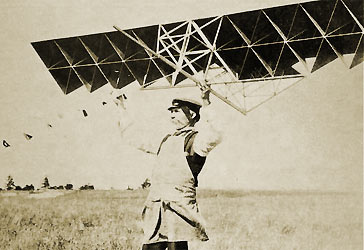 |
His years for kites |
||||||
1891 - 1909 |
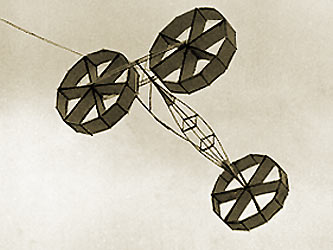 Cerf-volant de Bell à 6 cellules |
While working on the telephone, Bell mentioned to Watson that their next project would be a flying machine. On his honeymoon, he told his wife Mabel that he dreamed of flying machines with telephones attached. Like the Wrights and other aviation pioneers, Bell chose to test light, wind-supported kite and glider designs before attempting risky human-powered flight trials. By the summer of 1891, Bell is interested in aeronautics, began his experiments in Baddeck and contributed $5,000 for aviation experiments of Samuel Pierpont Langley, his friend and Assistant Secretary of the Smithsonian Institution in Washington. |
|
In January, 1892, Bell publishes an article called Flying Machines of the Future in which he describes passenger carrying flying machines capable of long distance flight. Late 1894, he begins tests of wings and propellers. He tests helicopter models and quickly moves on kites as the most stable structure for human flight. On May 6, 1896, he attended the successful flight of Langley, with an airplane model of steel, steam-powered and driving two propellers, successfully catapulted from one bank of the Potomac, travel about 900 m. |
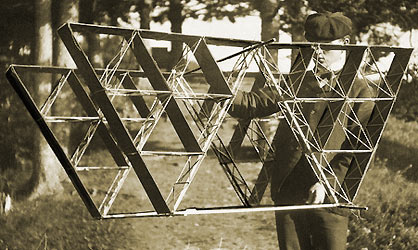 |
Bell photographed the flight of this model.. Speaking of this experience later, he said, "The sight of Langley's steam aerodrome circling in the sky convinced me that the age of the flying machine was at hand." Nothing better illustrates Bell's independence of thought than his staunch support of aviation at a time when it was considered so quixotic a subject that. Bell risked his scientific reputation in so doing and not to injure his professional reputation, he limits its flight tests kites at Baddeck. In spite of doubts, the population of Baddeck was soon pulled into Bell's kite flying activities. |
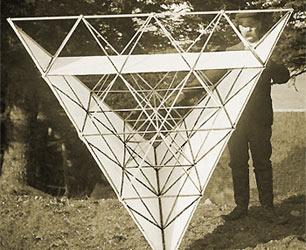 |
Young girls sat sewing in the kite house, surrounded by piles of bright red silk. Young men were engaged to take photographs or work the pulleys. Older people became accustomed to seeing galloping horses careening across the meadows, in often vain attempts to lift the kites. By 1898, Bell becomes president of National Geographic Society, regent of Smithsonian Institute. |
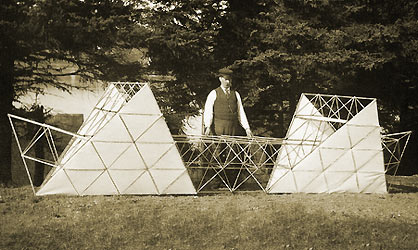 |
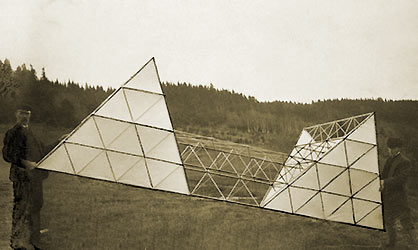 |
Bell hoped to develop a kite large enough to carry a man. But how could increase the size without increasing the weight? His first innovation was the triangular box kite. By removing one of the kite's sides and joining the remaining two sides together, he could remove one of the wooden sticks. |
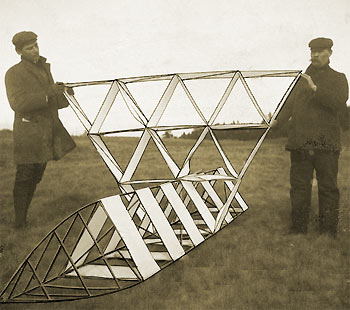 |
This decreased the weight and had a positive effect on stability. Moreover, a triangle is a more stable shape than a rectangle, which tends to distort in the wind. The next step was to combine several small triangular kites. By adding many small surfaces, Bell increased the total surface area, with little increase in weight. Eventually, he evolved a figure made up of four equilateral triangles. This was the tetrahedron, one of nature's most stable structures. Thus, from 1902, Bell invents the tetrahedral kite, whose shape of four triangular sides would prove to be light, strong, and rigid, form which gave stability for the kite. Once Bell conceived this form, he quickly grasped its potential. . He realized that it could be made very cheaply, of metal. |
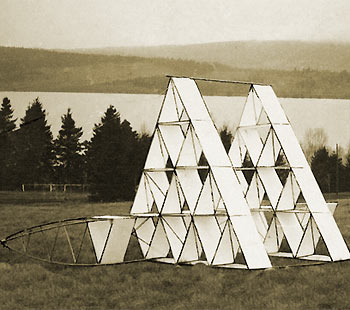 |
On his notes, August 25, 1902, Bell made sketches of bridges that resemble our own bridges. But Bell’s vision for a tetrahedral airplane was overshadowed by the Wright brothers’ successful biplane design (1903, decembre,17) |
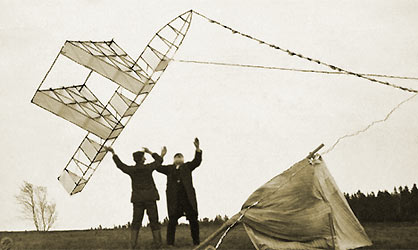 |
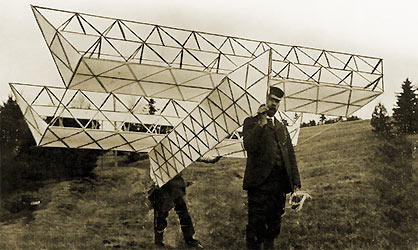 |
On August 31st,1904, Bell records in his Home Notes, “After years delay fighting patent office has at last granted my tetrahedral application ... have telegraphed ... to pay final fee so that patent may be issued immediately. This stimulates me to go ahead.” |
« In 1899, I made a communication to the Academy upon the subject of " Kites with Radial Wings" and some of the illustrations shown to the Academy at that time were afterwards published in the Monthly Weather Review.
Since then I have been continuously at work upon experiments relating to kites. |
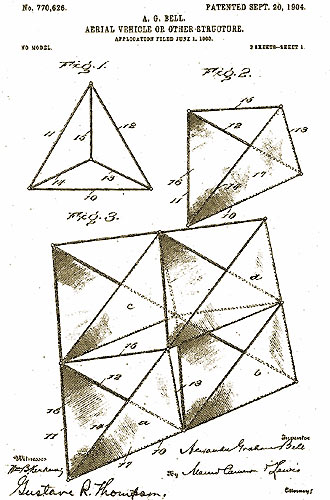 |
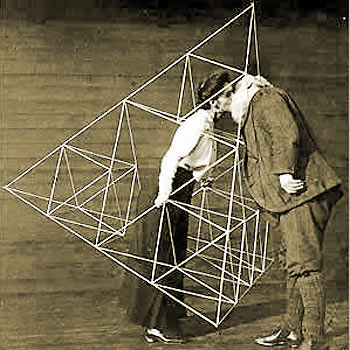 Marian (Daisy) Bell and Alexander Bell |
We are all of us interested in aerial locomotion; and I am sure that no one who has observed with attention the flight of birds can doubt for one moment the possibility of aerial flight by bodies specifically heavier than the air. The point I have had specially in mind is this: That the equilibrium of the structure in the air should be perfect; that the kite should fly steadily, and not move about from side to side or dive suddenly when struck by a squall, and that when released it should drop slowly and gently to the ground without material oscillation. I have also considered it important that the framework should possess great strength with little weight. In my younger days the word "kite" suggested a structure of wood in the form of a cross covered with paper forming a diamond-shaped surface longer one way than the other, and provided with a long tail composed of a string with numerous pieces of paper tied at intervals upon it. In Europe and America, such a kite is simply a toy. |
In Asia kite-flying has been for centuries the amusement of adults, and the Chinese, Japanese, and Malays have developed tailless kites very much superior to any form of kite known to us until quite recently. It is only within the last few years that improvements in kite structure have been seriously considered, largely due to the efforts of one man: "Mr. Laurence Hargrave", of Australia. His researches, published by the Royal Society of New South Wales, have attracted the attention of the world, and form the starting point for modern researches upon the subject in Europe and America. Scientific kite-flying has everywhere been stimulated by Hargrave's experiments. |
||
In America, the chief stimulus to scientific kite-flying has been the fact developed by the United States Weather Bureau, that important information could be obtained concerning weather conditions if kites could be constructed capable of lifting meteorological instruments to a great elevation in the free air. |
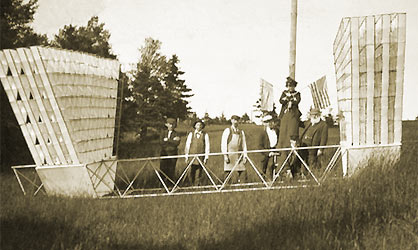 |
Mr. Eddy and others in America have taken the Malay tailless kite as a basis for their experiments, but Professor Marvin, of the United States Weather Bureau; Mr. Rotch, of the Blue Hill Observatory, and many others have adapted Hargrave's box kite for the purpose. Congress has made appropriations to the Weather Bureau in aid of its kite experiments, and a number of meteorological stations throughout the United States were established a few years ago equipped with the Marvin kite. Continuous meteorological observations at a great elevation have been made at the |
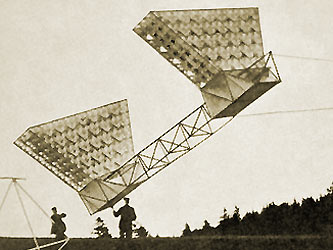 |
Blue Hill Observatory in Massachusetts, and Mr. Rotch has demonstrated the possibility of towing kites at sea by means of steam vessels so as to secure a continuous line of observations all the way across the Atlantic. » (A. Bell - Reprint from Geographic Magazine Vol. XIV, No.6, June 1903). |
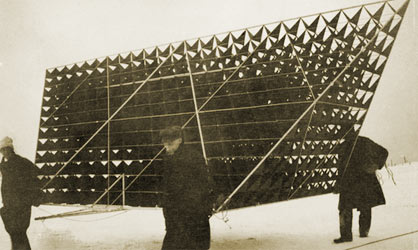 Frost King |
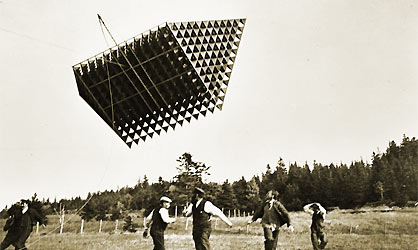 Frost King |
This Bell's work was greatly expanded in the following years. Giant kites of multicellular, tetrahedral form were built and flown. |
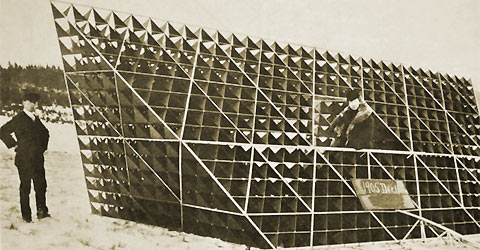 |
December 1904 at Baddeck: Alexander Graham Bell fly the "Frost King", composed of 1300 cells of red silk, 10 inches on a side. Each cell weighed under an ounce and all weighs only 60 lbs. (pictures above) On 18th, it supports Lucian McCurdy on a rope from the kite. The Frost King has raised four times its weight, it has a lifting capacity of about 243 lbs. From this Bell concluded that a much larger kite, carrying an engine, providing a 10 m.p.h. thrust would easily carry a man. December 28, 1905, during a flight, one of his assistants, Neil MacDermid, holding a rope connected to the kite is raised to 30 feet above the ground. |
"Siamese Twins" |
|
Few seconds until the start of video |
|
|
|
|
Tetrahedral kites of Alexander Graham Bell video of 3'32 |
Graham Bell's experiments on the tetrahedron |
| Source : Smithsonian Institution - Fitzgerald Canada - Parks Canada - AT&T - National Geographic Magazine (Vol. XIV, No.6, June 1903) - Alexander Graham Bell National Historic Site - Dictionary of American Biography Base Set. American Council of Learned Societies, 1928-1936. Photos : Library and Archives Canada - Library of Congress American Memory - Smithsonian Institution - National Geographic |
His years for kites |
||||||
